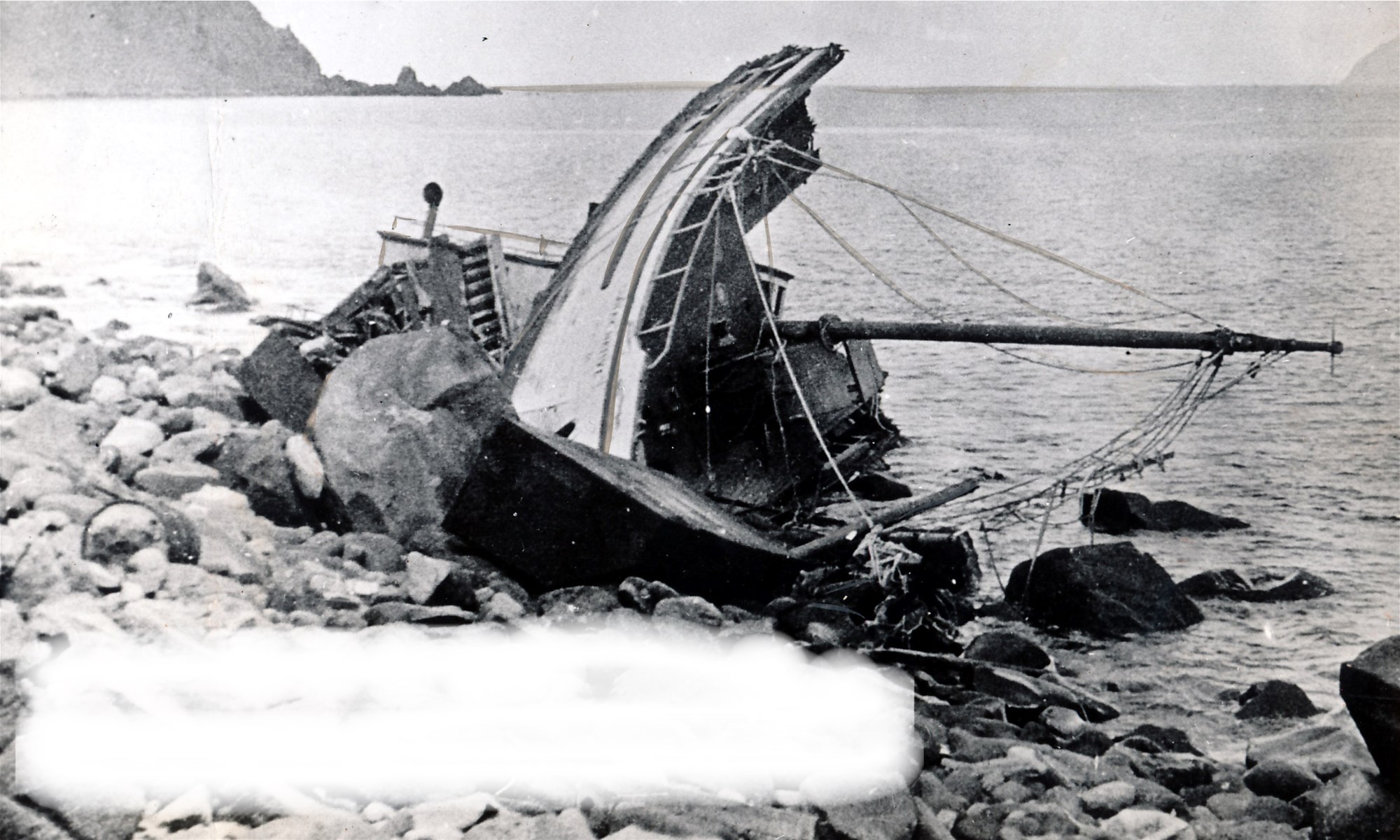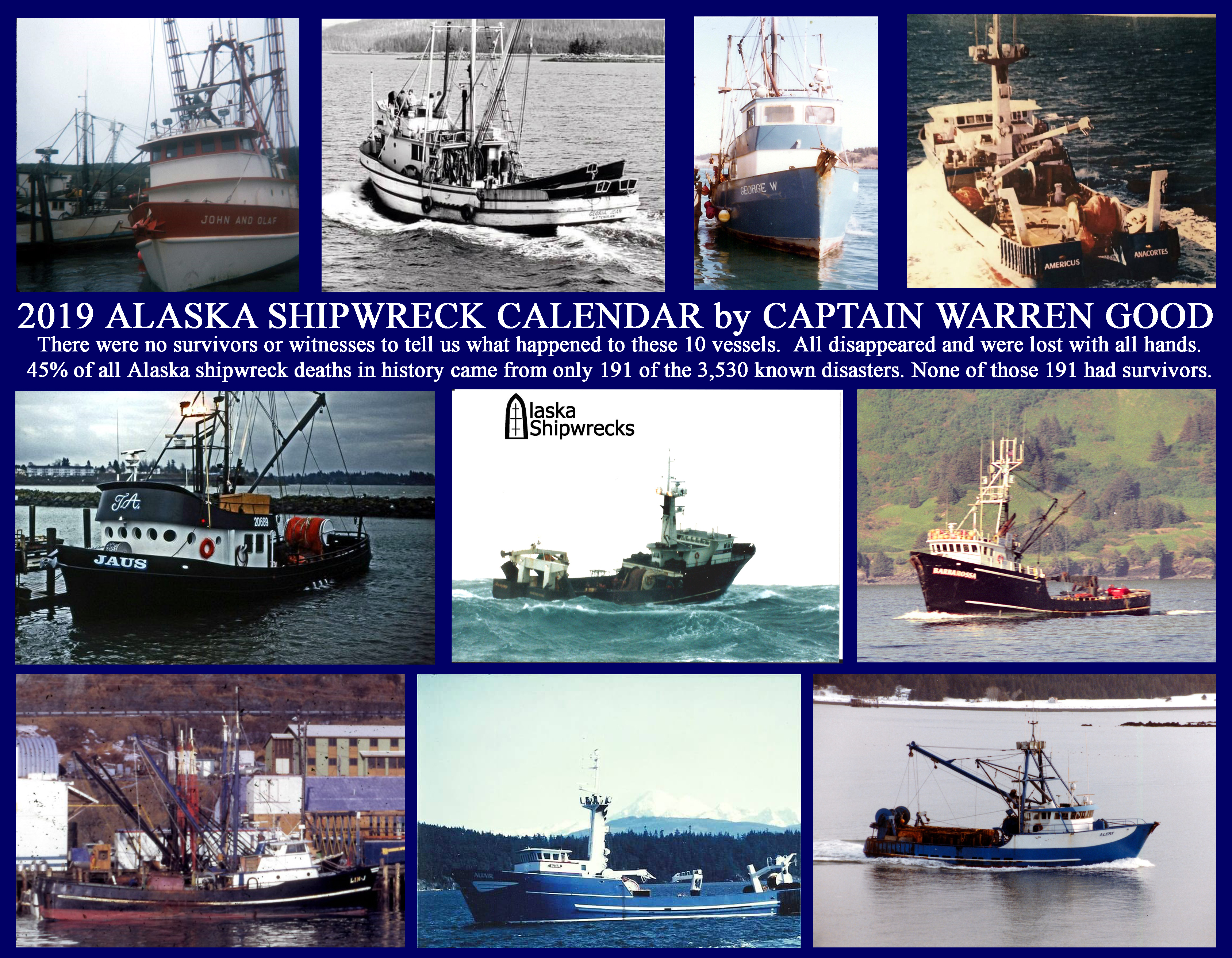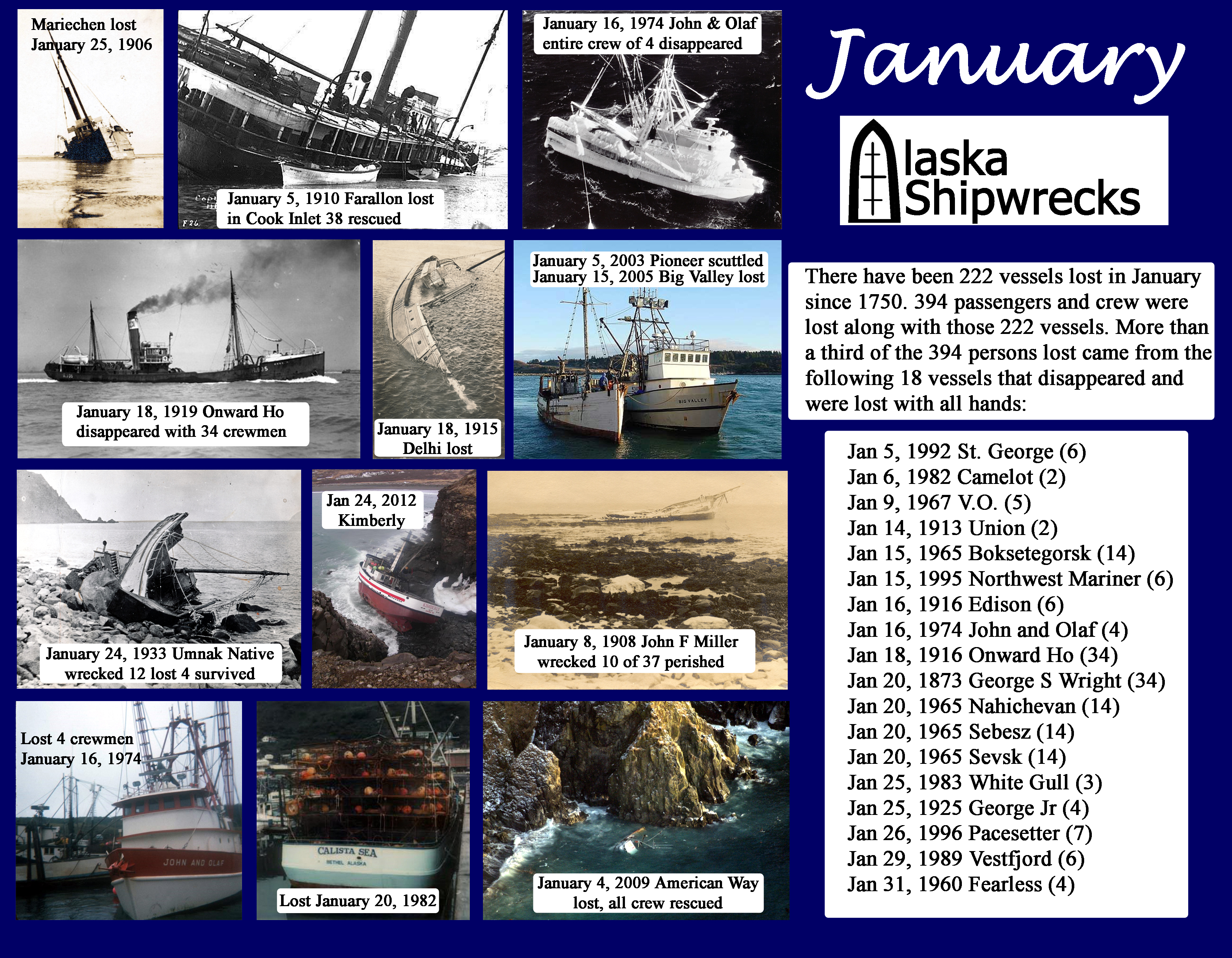For those of you interested in my 2019 Alaska Shipwreck Calendar and the book that compliments it that I have just released, “Alaska Shipwrecks: 12 Months of Disasters”, there is a review of the new book on the following blog: http://www.alaskaforreal.com/
2019 ALASKA SHIPWRECK Calendar and ALASKA SHIPWRECKS: 12 Months of Disasters
The 2019 ALASKA SHIPWRECK Calendars are now available at Lulu.com. I have also just released a new book called ALASKA SHIPWRECKS: 12 Months of Disasters. It is an accounting of the most significant 275 Alaska shipwrecks in history. First hand accounts from survivors are presented in addition to the descriptions of the disasters. The book is presented in a month by month format and compliments the Alaska Shipwreck calendars very well. Go to Lulu.com and search Alaska Shipwrecks to find both the book and calendar.
On this year’s calendar I am spotlighting the vessels that have disappeared and been lost with all hands. They account for a high percentage of all deaths in history that happened during the cold weather months.
ALASKA SHIPWRECKS 1750-2015 Now Available in Soft and Hard Cover
ALASKA SHIPWRECKS 1750-2015 by Captain Warren Good and Michael Burwell is now available on demand in both soft and hard cover. Hardcover books are being discounted by 20% and softcover by 30% for orders purchase directly from Lulu.com. Please follow the yellow link to order softcover and blue for hard.


This is the second edition of ALASKA SHIPWRECKS and contains much more information than the previous work including expanded detail and information particularly on the larger and more significant shipwrecks in Alaska history. Thousands of names of those lost have been researched and are published in this Alaska shipwreck encyclopedia that have never been available before. Captain Warren Good has combined forces with marine historian Michael Burwell to produce the largest and most complete accounting of Alaska shipwrecks ever.
Out with the old and in with the New
The First Edition of ALASKA SHIPWRECKS: 1750-2010 will soon become unavailable and out of print, to make room for a new edition later this year. If anyone wants a copy of my original and first edition work for their collection, they can be purchased by going to Lulu.com and searching the book title or my name; Captain Warren Good. The new version will be titled ALASKA SHIPWRECKS 1750-2015 and I will be co-authoring with marine historian Michael Burwell. We hope to have that one available this summer.
Alaska Shipwreck Coldcase
On April 3, 1979 a survival suit was manufactured in California. These suits, also called immersion suits or exposure suits were becoming popular with the Alaska fishing fleet for surviving in the icy waters of the north in the event of a shipwreck. Each was often marked with the name of the manufacturer and a serial number specific to that suit. On November 19, 1982 one of these survival suits washed up on a beach in Hawaii with the remains of a young man in his early to mid twenties in it. He was wearing a survival suit manufactured on April 3, 1979. We know because it had a serial number. He appeared to have been in the water for a very long period of time. This young man has yet to be identified. Technology and science have advanced greatly in the 36 years since that survival suit washed up in Hawaii. Studies indicate that it would take a floating object from a shipwreck near Alaska at least two years to arrive in Hawaii traveling in the Alaska Stream Current to the North Pacific Current and then on to Hawaii. It is possible that the young man who washed up in Hawaii came from a shipwreck in Alaska. I have gone over all Alaska shipwrecks after the April 3, 1979 date that the suit was manufactured until the middle of 1981. After mid-1981 it is very unlikely that something or someone would have the time to drift to Hawaii and arrive by the November 19, 1982 date when the body in a survival suit washed up in there. The wrecks that stand out from April of 1979 until mid-1981 are the Hellion of November 23, 1979, Gemini of January 15, 1980, Norel March 17, 1980 and Commander of November 21, 1980. I am looking for your help. If you know anyone or anything about these four vessels, please contact me at warren@alaskashipwreck.com as soon as possible. With all the new advancements in science and technology, we may be able to solve this sad shipwreck cold case from 1982.
The names of those lost with the Hellion in 1979 were captain and owner Ronald Hoffman of Seldovia, and crewmembers Walt Laughhead of Seldovia and Aaron Going (19) of Oregon. Lost with the Gemini in 1980 were captain Roy O’Harrow and crewman Steve Holden. Lost with the Norel in 1980 were owner Joseph Gursky, Roseanna Nasello and John Estrada. Lost with the Commander in 1980 were four family members including Philip Edwards and his son Philip Jr., his brother John Edwards and his nephew Sam Bissett, all from Seattle. The smallest piece of information about these boats or the people that went missing with them may be helpful. I will keep all names and information confidential unless otherwise instructed. Thanks in advance…Captain Warren Good
Week 31 in Alaska Maritime History July 30 – Aug 5
By Captain Warren Good
July 30, 1956 The 30 foot troller Linda swamped and sank. No one knew what happened to the vessel until a message in a bottle was found off of Yakutat in the Gulf of Alaska a full year later. The message came from the only occupant of the Linda, 16 year old Orville Rude, son of the owner. He had been taking his father’s boat to Inian Pass from Elfin Cove to fish when the vessel swamped.
August 1, 1969 Canadian halibut fishing vessel B C Clipper exploded and sank off of Twoheaded Island near Kodiak. Five crewmembers were rescued but three were lost. A liquid gas line from the galley freezer broke and caused the initial explosion when the gas was ignited by the galley stove. Winston Tucker and his son Clarence Tucker, both of Vancouver were lost along with Charles Stanley of New Westminster. Five survivors were rescued by the fishing vessel Peggy Jo.
August 3, 1966 the Columbia Wards Fishery Company cannery, four buildings and about 50 stored fishing vessels were destroyed by fire 10 miles north of Naknek on the Kvichak River. The buildings had not been used for canning since 1958. They were primarily used to store gillnet vessels for the North Star Fish Company and Alaska Fish Company.
August 3, 1888 the Young Phoenix, Mary&Susan, Ino, Fleetwing and Jane Grey became trapped in ice and lost. The crews were rescued by the United States Revenue Cutter Bear.
Week 30 in Alaska Maritime History July 23 – July 29
Summer is a relatively calm time of year and shipwrecks are less frequent. Small boat accidents are more common and tragically sometimes multiple family members are involved. Such was the case July 25, 1976 when the 34 foot wooden gasoline powered salmon troller Miller’s Bay disappeared near Noyes Island with three family members aboard, including Robert West (31), his wife Judy (30) and their 14 year old daughter Brenda.
The number of fires increases during the summer with the increased number of small vessels active in recreation and fisheries. The maritime community is also plagued with similar tragedies when canneries and packing plants are lost to a similar fate. Several lost during week 30 are as follows:
July 25, 1921 the Libby McNeil and Libby salmon cannery at Kenai was destroyed by fire with an estimated loss of $300,000.
July 26, 1924 the Alaska Sanitary Packing Company cannery at Wrangell was destroyed by fire. The loss was estimated to be $200,000.
July 28, 1916 the Nakat cannery near Ketchikan owned by the Humes Interest was destroyed by fire. Only a few hundred cases of salmon had been packed.
Weekly Alaska Maritime History for Week 29
We are in the middle of the 29th week of the year, which by my reckoning covers July 16th to July 22nd. I have decided to post a weekly accounting of the significant maritime events of each week in Alaska history that I have run across in my research. The three that stand out for the 29th week of the year are as follows:
July 18, 1935 The wood hulled gas screw Bessie M caught fire Tuesday at 1:30 p.m. while at the float dock at Excursion Inlet. No one was on board at the time. The vessel was towed away from the dock and a hole was chopped in her side subsequently sinking the Bessie M and “checking the flames”. Because of the sinking, her engine and the lower part of the hull were saved. The cause of the blaze has been attributed to “gas fumes”. I am including this small event because there is a lesson that many mariners should pay attention to. Literally hundreds of vessels have burned and become total losses in the Alaska marine environment without the simple action that was taken to stop the flames and save this boat. The Bessie M was put it in “Wet Storage” until she could be re-floated and the damage repaired. This method is seldom thought of in the heat of the moment. Another example I have in my files is of a vessel owner who puts out an engine room fire by blasting holes in the hull below the waterline with his shotgun.
July 19, 1903 the Kenai salmon cannery owned by Pacific Packing and Navigation Company was destroyed by fire. Once owned by Pacific Steam Whaling Company, the cannery could produce 60,000 cases of salmon a season. There was enough insurance to cover the loss.
July 20, 1784 an unknown Japanese junk out of Shiroko wrecked on Amchitka after drifting more than 7 months. The following is an excerpt from a letter written February 26, 1791 to Count Aleksandr R Vorontsov by Kyrill Laksman detailing the plight of Japanese castaways rescued in the Aleutians by Russian Promyshlenniks:
“On December 13, 1783, seventeen Japanese men sailed out from the town of Shiroko to trade in the capitol city of Yedo. At the halfway point of their voyage they, like many similar vessels, stopped to spend the night in Semioda Bay. During a violent windstorm another vessel hit them and broke off their rudder. Without the rudder they had to cut the mast, and thus they drifted at the mercy of the waves for more than seven months, drifting in various directions. At last on July 20, 1784 they came to the Aleutian Island of Amisachka where they dropped anchor and went ashore in a small boat. They found seven Aleut men there who were hunting wild geese. The Aleuts invited the five Japanese into their earthen iurts and gave them cooked goose and fish to eat. Toward evening Russian promyshlenniks came to the island from a vessel which had been wrecked on the island, a vessel which belonged to the Totma merchant, Khodilov. The Russians went to the Japanese vessel and spent the night in a cabin on shore, but during the night there was a storm at sea and the anchor broke away on some sharp rocks underwater. The ship was cast adrift and then was wrecked on the coast. Thus, deprived of their last hope, the men had to remain on that island for three years and a month, during which time the Russian promyshlenniks used planks from their wrecked vessel, and the remains of the Japanese vessel, which had been built of redwood and camphor, to build a new vessel. In September of 1787 they took the remaining nine Japanese men with them to Nizhnekamchatsk ostrog. Seven of the Japanese had died while they were on the Aleutian Island, and an eighth was killed during a storm at sea”
PRINCESS SOPHIA passenger list
One of the primary functions of this website is remembering not just the vessels lost in Alaskan waters but the people lost with them. That information is not just historically interesting, it is important to families and their descendants when a loved one is lost to maritime disaster in Alaska. With that in mind, I have posted a new, never before seen list of 461 names of people that may have been lost when the Princess Sophia sank in 1918. The official counts vary from 343 to 356 persons lost. The Sophia is Alaska’s worst maritime disaster to date. There were no survivors, with the exception of one of the passenger’s dog. What I have done to to arrive at such a large number of people lost relative to the official count is to include all names that were published as passengers or crew lost when the vessel went to the bottom. I used newspaper publications from Alaska, Oregon, Washington and British Columbia. I also included the most comprehensive list published in book form. None of those lists appear to have ever been complete. There are just too many names. Many of the names on my list are of people whose bodies were identified but never included in the official count. This list is unofficial and likely incomplete, but may prove helpful for locating a missing ancestor. Now that the list is published online, the names will come up in searches. For the complete list go to the A to Z section and pick the letter P. Once there scroll down to PRINCESS SOPHIA. At the end of the list is a link to download the complete list, color coded and in .pdf format.
Finding an Alaska Shipwreck or Lost Alaskan Fisherman
If you are looking for a boat or ship and know the name, click on the Alaska Shipwrecks A-Z link above and search the alphabetical listings. If you know a fisherman’s name and about when they were lost click on the Alaska Recent Maritime Losses 1972-2009 link above and read through the years when the loss occurred. If you are interested in shipwrecks from a particular area click on the Shipwrecks by Area 1740-1940 link above and search in the area of your particular interest. If you are interested in a particular period in history or an individual year click on the Alaska Shipwrecks 1729-2010 and download the chronological pdf file of the BOEM Alaska Shipwreck List by clicking on the link shown.
This website is far from complete but contains thousands of pages of useful information about Alaska Shipwrecks. ALASKA SHIPWRECKS is now available as a pdf file book that can be purchased and downloaded. Just click on the book store link on the right side of this page and you will be directed to the Alaska Shipwrecks Bookstore page. Thank You for Visiting and Smooth Sailing…. Captain Warren Good

Please respect copyrights



